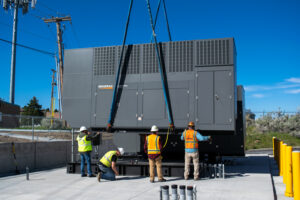
Recommended transfer switch maintenance schedule
In the event of utility power failure, your transfer switch is one of the two most crucial pieces of equipment to make sure you get backup power to your home or business (The other is your generator). Your transfer switch needs to be well maintained like any other piece of equipment, but is often overlooked. A good maintenance schedule will help your switch operate optimally in the event of a power failure. In this article we will go over what maintenance should be performed, and when, to keep your transfer switch in good working condition.
Weekly
A weekly visual inspection is a good idea to help extend the life of your transfer switch. Open the switch-gear cover to do a quick visual check of the cleanliness, color, and condition of all inside parts. Be sure to remove any dust or debris with a vacuum or microfiber cloth anytime you perform a check to keep abrasive particles at bay.
Monthly
You should perform routine testing of your generator and transfer switch, under load and operating temperature, at least once a month. A thirty minute exercise period is the minimum amount of time you should be running your generator for your monthly load tests. The NFPA requires testing of diesel generators to be performed with at least a 30% load for 30 minutes every month. The load rating for your specific generator can be found on the nameplate or in the manufacturer specifications.
Check out the inside of your switch box. Is it clean and clear from debris? Are there any strange sounds coming from it? Are all terminals and connectors their normal color? Is the condition of all wiring and insulation good? Are all covers tight?
After all maintenance is completed, make sure the switch and generator are in auto, and be sure the doors are securely closed to make sure dust and debris is kept to a minimum.
Annually
Once a year, a qualified technician should be doing in depth inspection and testing of your transfer switch. Following the steps below will help keep your transfer switch in tip top shape:
- Perform infrared scans or thermal imaging while machinery is in operation to look for potential hot spots.
- Make your equipment safe by de-energizing. Inspect the surrounding area for safety hazards or potential maintenance issues.
- Remove the arc chutes and pole covers. Visually inspect the main and arcing contacts.
- Test and re-calibrate all AC trip sensing and time delay functions. Record and verify that the current settings suit the needs of your application.
- Check the inside for dust and debris. Use a vacuum or soft cloth to remove it. Never use air to blow out debris, as it can actually lodge things further inside the switch-gear and cause static electricity to build up.
- Inspect the inside for moisture or signs of previous wetness or corrosion. Clean out any grime with a cleaning solvent. Using rubbing alcohol and a microfiber cloth is usually a safe bet, but be sure to check with the manufacturer first.
- Inspect all insulation for cracks or discoloration from excessive heat.
- Inspect all main arcing contacts for corrosion or pitting due to excessive heat. Pay careful attention to these contacts and replace readily as needed.
- Manually operate the main switch to check for proper movement, contact alignment, gap, wiping action, and deflection.
- Check all cables and connections to the controller, sensing panels, and other system components. Tighten as needed.
- Perform automatic transfer tests.
- Simulate loss of normal power, return to normal power, simulate loss of emergency power, and simulate all forms of single-phase conditions.
- After all testing is completed; remember to set your switch-gear back to auto.
At any point during testing, all worn or inoperative parts need to be replaced by a qualified technician.
Got More Generator Questions? We Can Help!
Call 800-595-5315 Or Connect With Our Expert Technicians Here:
Other Articles
- Critical Spare Planning
- Where Do I Start On My Generator Installation?
- How can Las Vegas heat lead to generator failures?

Lead Generator Technician
Graduated from Idaho State University with a degree in Heavy Duty Diesel and Onsite Power Generation. Damien is a master tinkerer and has been working on anything with a motor since he was about six years old. Besides being a generator fanatic, Damien is also an avid snowmobiler and aspiring world traveler.





